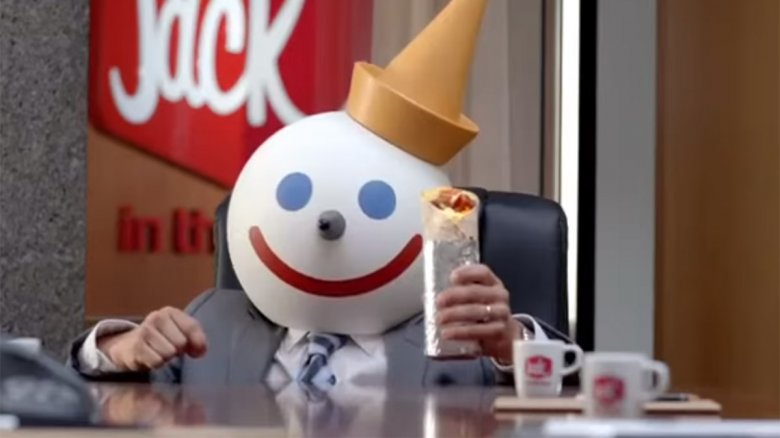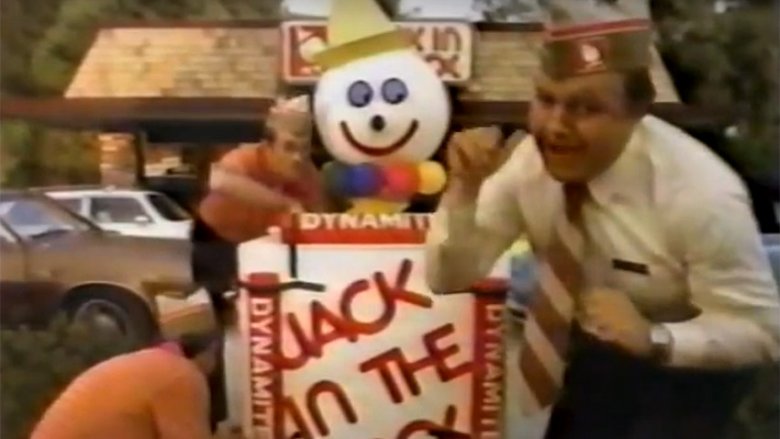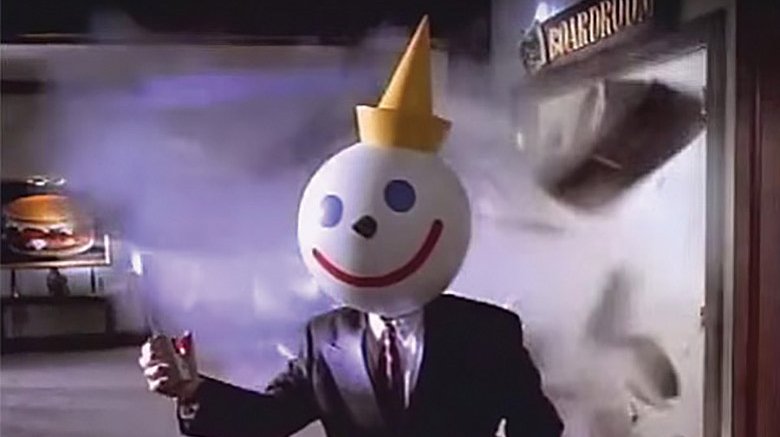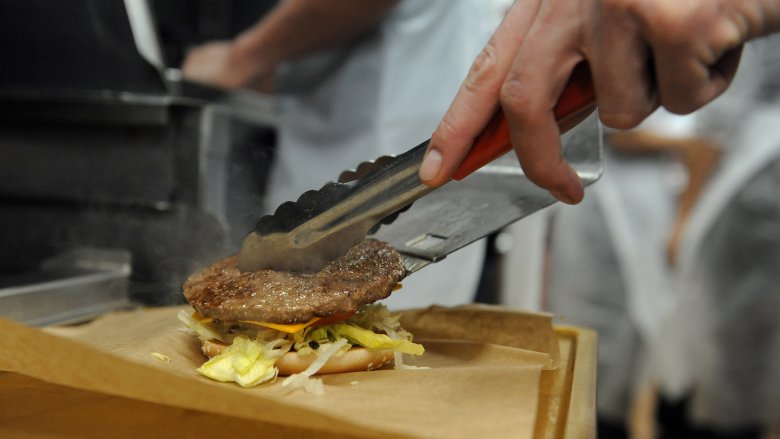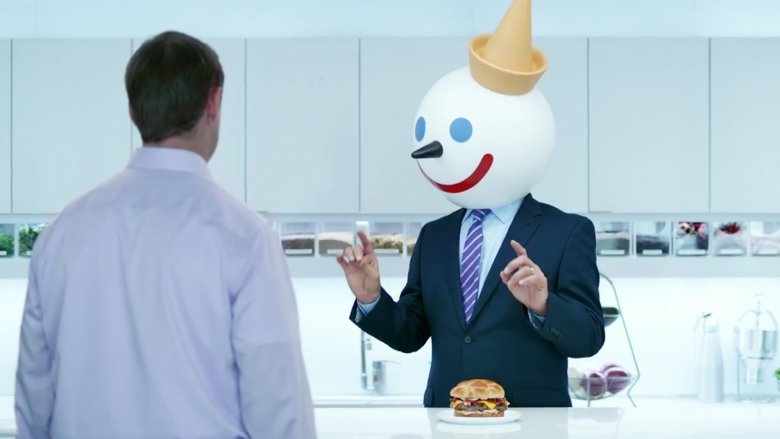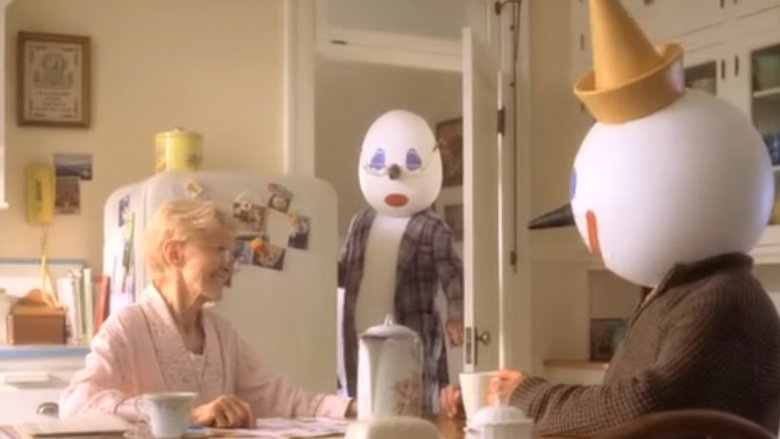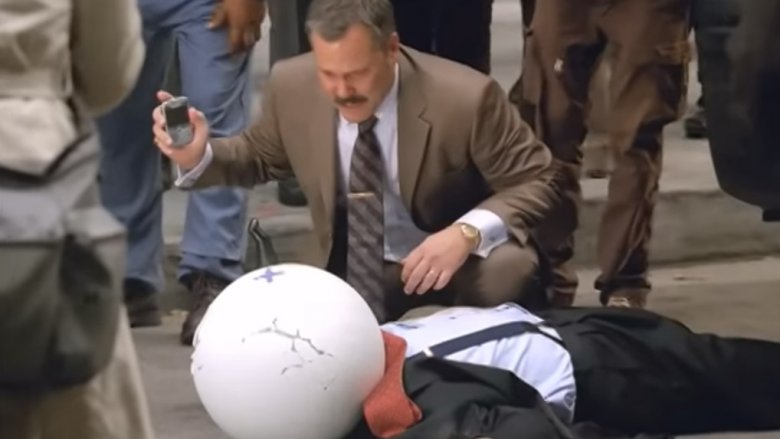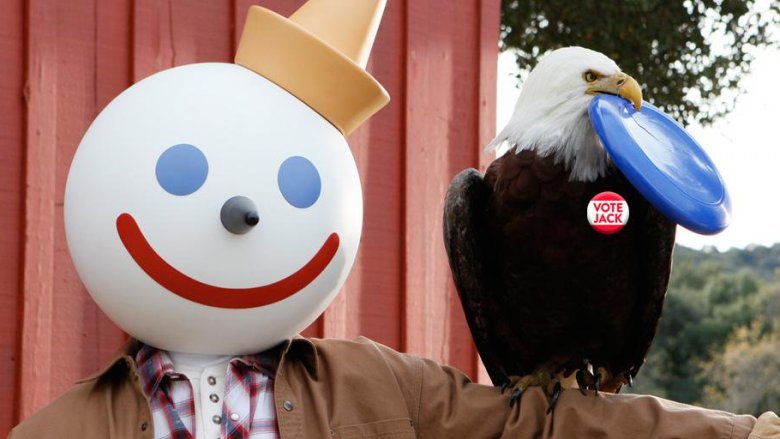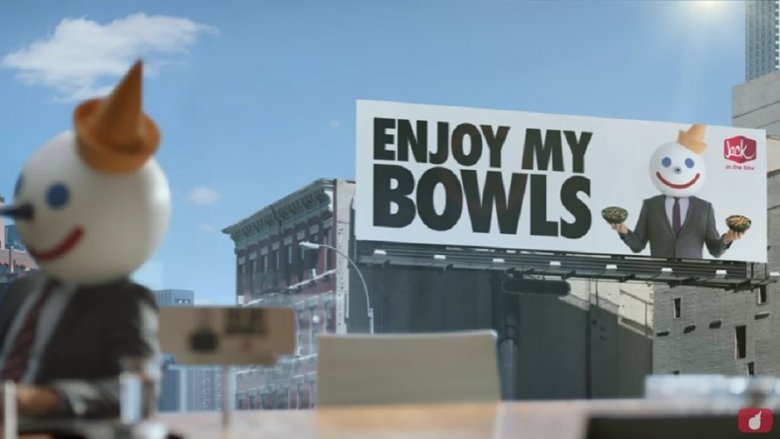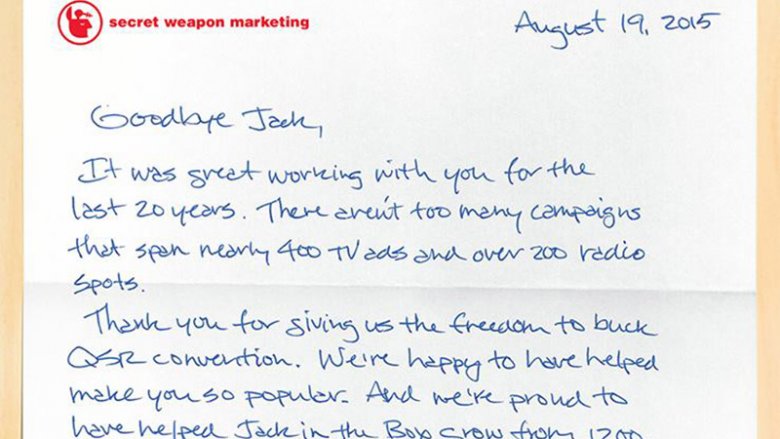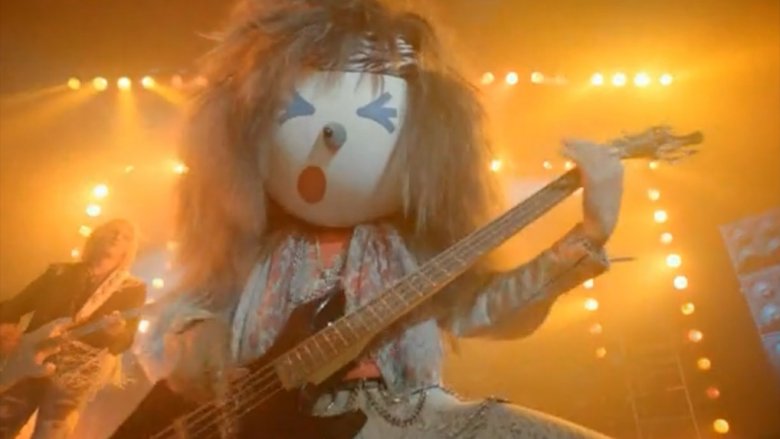The Strange History Of Jack In The Box's Jack
When it comes to clowns in the fast food business, Ronald McDonald might be a bigger hit with the kiddos, but he's all fluff and no follow through. Sure, Jack Box of Jack in the Box has a ping-pong clown head, but clowning around is hardly the image he portrays. In the hundreds of ads he's appeared in over the years, Jack showcases himself as a businessman who gives the people what they want. Sometimes that means running for president and other times it means creating a combo meal for stoners.
Jack wasn't always the popular character that fast food fans know him as today though. He was almost completely absent from the restaurant in the 1980s, and it took a health nightmare to bring him back. From his weird head to his hobbies and commercial successes, here's everything you ever wanted to know — or perhaps never even thought about — when it comes to Jack Box.
Jack in the Box killed Jack
Long before Jack became the ball-headed CEO that fans love today, he was simply a clown stuck on the roof. When Robert O. Peterson opened the first Jack in the Box location in San Diego, California in 1951, Jack was the clown head mascot sitting atop the restaurant's roof to grab the attention of passing motorists.
The clown head was also prominent on the restaurant's drive-thrus, but by the late 1970s, the Jack in the Box executives began to feel that the clown mascot was a little too childish. In 1980, Jack in the Box decided to do away with Jack the clown in a TV commercial where they literally blew up Jack claiming that "cute was the old Jack in the box."
With Jack gone, the company wanted to further distance itself from the image of clowns in boxes and changed the name of some locations to Monterey Jack's. The company admitted in a TV spot, however, that the name change was about as popular as cold french fries. By the mid 1980s, Monterey Jack's was back to being Jack in the Box, but Jack was still nowhere to be seen.
Jack's explosive return sparked controversy
Jack returned to the company just the same way as he had left — with a bang. Rick Sittig and Lee Clow of Chiat/Day advertising wanted Jack's return to connect with young men and thought up a commercial that played on his previous, explosive exit. In the comeback ad, Jack is a businessman who gets his revenge on the corporate goons who got rid of him by blowing up their boardroom.
As clever as the new commercial might have been, not everyone was cool with how Jack made his return. When Jack came back in late 1994, the news was filled with acts of terrorism including a fire bomb on a New York City subway car, mail bomb in a New Jersey suburb, and suicide bombers in Israel's bordering Gaza Strip. Critics argued that the commercial was poorly timed and insensitive to the violence in the news.
"I understand they have to catch the attention of male teenagers, who are going to say, 'Yeah, cool, man' and maybe not take it seriously," Mary Fox, vice president of the corporate image consultant Addison Seefeld & Brew, said at the time. "But I just think it's inappropriate."
The company defended the ad, saying that the nature of the content had been discussed, but it was ultimately decided that it could be done in a "cartoonishly humorous fashion." Obviously, it worked and Jack is still kicking around today.
Jack emerged to help save the restaurant from ruin
Jack of course didn't come back simply because the restaurant wanted to make funny commercials. The early 1990s were not good times for Jack in the Box. Profits were down, and they were fading fast as a serious fast food competitor. "They had spent a lot of energy promoting a wide variety of products that were becoming less and less relevant in the marketplace," John Truscott, account director at the agency responsible for Jack said.
Lack of product identity was just part of Jack in the Box's problem in the early 1990s though. They found themselves at the center one of the biggest fast food scandals ever in 1993, when E. coli bacteria from improperly cooked burgers lead to the hospitalization of hundreds of customers and the deaths of four children. The PR nightmare cost the restaurant chain $140 million, and nearly sank the company.
Aside from implementing a new and more stringent food-safety program, Jack in the Box responded by rebranding with a revamp of its clown mascot as a "no-nonsense, smart-talking exec." Sittig said that the goal with Jack was to get everybody to "forget about the E. Coli incident and... put a fresh face on the company." The new Jack worked tremendously for the company with a reported "18 consecutive quarters of growth since the Jack campaign started," according to AdWeek.
Jack isn't afraid to use some muscle on critics
If the food from Jack in the Box doesn't suit your refined palate, you had best keep it to yourself. Because if Jack finds out, he will beat you down into submission. Don't believe us? Just look to this 1997 commercial that parodied COPS. In the ad titled "The Visit," Jack visits Brad Haley, a man who has been calling the restaurant "junk in the box" and proceeds to drag Haley onto the lawn and force feed him a burger, fries, and shake. When Haley eventually agrees that the food is good Jack reminds his critic that he could snap his "arm like a twig." Savage, Jack!
"It took me a year to sell that one," Dick Sittig told AdWeek, "and another year to get it produced." The commercial was only shown after 10 p.m. and did receive some blowback from uptight critics, but proved to be a success for Sittig and won an advertising award the following year.
Jack has some interesting family history
Alright, so we can't talk about Jack without addressing the ping-pong ball that he has for a head, despite having a normal human body. So what's up with that? Well, according to Jack in the Box's website, the odd clown head is some sort of genetic mutation that only affects males in Jack's family tree. That's right, women like Jack's wife Cricket and mother are completely normal human females, while Jack's father and son have clown heads just like Jack. Yeah, it's weird.
While we're on the subject of Jack's family, we might as well point out that it's a little dysfunctional. Running a million-dollar fast food empire, Jack is obviously the most successful member of the family, but he also has some hick cousins in Philly who have mullets growing out of their clown heads and probably enjoy such pastimes as throwing rocks at passing trains. Even more intriguing, is that another ad revealed Jack has a cousin serving time in prison. What Jim Box is serving time for is never made totally clear, but given Jack's penchant for violence and Jim saying he'd "kill" for a bonus jack combo, he's probably not doing hard time for insider trading.
He was nearly killed by a bus in 2009
It's not easy being Jack. Despite the success he's brought Jack in the Box since his return, he was nearly killed again in 2009 when he was run over by a bus. In the Super Bowl ad, Jack is seen talking with a colleague as he crosses an intersection at the ironically named Hope street when he's creamed by a city bus. With a cracked ping-pong head, the fate of Jack remained uncertain with viewers being encouraged to visit hangintherejack.com, where they could leave well wishes for their beloved clown hero.
The commercial was part of a lengthy marketing campaign that saw Jack waking up out of his coma in order to prevent the company from changing its name to Phil in the Box. Of course, the real reason for the ad campaign was that the company was redoing its logo, which included a bigger emphasis on the word "Jack," as well as an expanded menu. Considering that 67,000 people signed up to receive updates on Jack's hospitalization, it's evident that sometimes it pays to run over your mascot with a bus.
He ran for president of the United States
Jack is a man of the people and that doesn't just mean giving the public dirt cheap combo meals, but going so far as to serve the as their commander-in-chief. Or at least attempt to do so, anyway. During the 1996 United States presidential election, the fictional Jack in the Box mascot and CEO made a bid for the White House against Bill Clinton and Bob Dole.
The fast food franchise ran a hokey ad portraying Jack as a family man and politician in-touch with the issues Americans cared about: education, the environment, and milkshakes. Jack didn't stop with just a single commercial though, and the company released pins and bumper stickers that read "Back Jack for President" and "Don't blame me I voted for Jack." For all you collectors of campaign merch from failed presidential candidates, you can even snag some of Jack's pins and stickers on eBay.
While Jack may not have won the presidency, according to the company's website, he did beat out Clinton in one national independent poll. Fans urged Jack to run in 2008, but alas, he kept both feet in the burger biz.
He's been called "tone deaf" for a tongue-in-cheek ad
Humor has been at the center of every Jack in the Box ad featuring Jack, and it often aims to be be edgy. Over the years that attempt at pushing the envelope with edgy humor has meant some critical blowback for the company, and a 2018 commercial found Jack in the hot seat once again.
The commercial for the company's bowl menu items featured Jack and other actors repeatedly referencing "my bowls" in a tongue-in-cheek way. The commercial even attempts to point out the sexual innuendo with a lawyer telling Jack he can't say "enjoy my bowls."
The ad didn't fly well with critics at AdWeek who called it "tone-deaf" in the #MeToo era, or with Golin Public Relations who labeled it "dangerous" and "lazy" for the brand.
Social media users felt the need to chime in too with some issuing the hashtag #boycottjackinthebox and others declaring it a case of "making issues out of non-issues." Regardless of your opinion of the commercial, Jack accomplished his mission and got people talking about his bowls — for better or worse.
Jack said goodbye to its creator after 20 years
Rick Sittig is Jack. He spearheaded Jack's return in 1994, served as the director for all of the commercials featuring Jack, and it's (maybe?) his voice delivering all those snarky Jack lines. In 2015, however, Sittig announced that he was parting ways with his clown-headed alter ego after two decades in the role.
Sittig's advertising agency, Secret Weapon Marketing, lost the account with Jack in the Box for unknown reasons, and Sittig penned a bittersweet goodbye to the character on Facebook. Part of the message read: "We're happy to have helped make you so popular. And we're proud to have helped Jack in the Box grow from 1200 to 2200 restaurants. Remember when we started together, how your stock price was $3? Who would have thought it would have hit $91?"
While Sittig might not be involved with the character he made famous, the voice of 2018 Jack is nearly indistinguishable from earlier Jack commercials. Hmm, exceptionally good casting or possible conspiracy?
Jack's Reddit AMA revealed he's a complex guy
You might think that Jack is just a pointy-nosed corporate clown who's only interest is in building up his fast food empire, but you'd be wrong. Jack is a complex man with varied interests and some odd habits.
A 2018 Reddit AskMeAnything session with Jack revealed everything from his morning routine — it's eight hours of meditation followed by a two minute shower — to his odd choice of Cholula hot sauce for a beverage. Obviously, Jack takes his job little too seriously at times and he even goes so far as coaching the curly fries.
Jack's life isn't just about burgers and fries though, the guy also enjoys the music of Snoop Dogg and met his wife at a Meat Riot concert in Oakland, California back in the 1980s. Did we mention that Jack used to play in a heavy metal band called Hot Mess? There's even video evidence for all you headbangers out there.
Rock on, Jack. Rock on.
